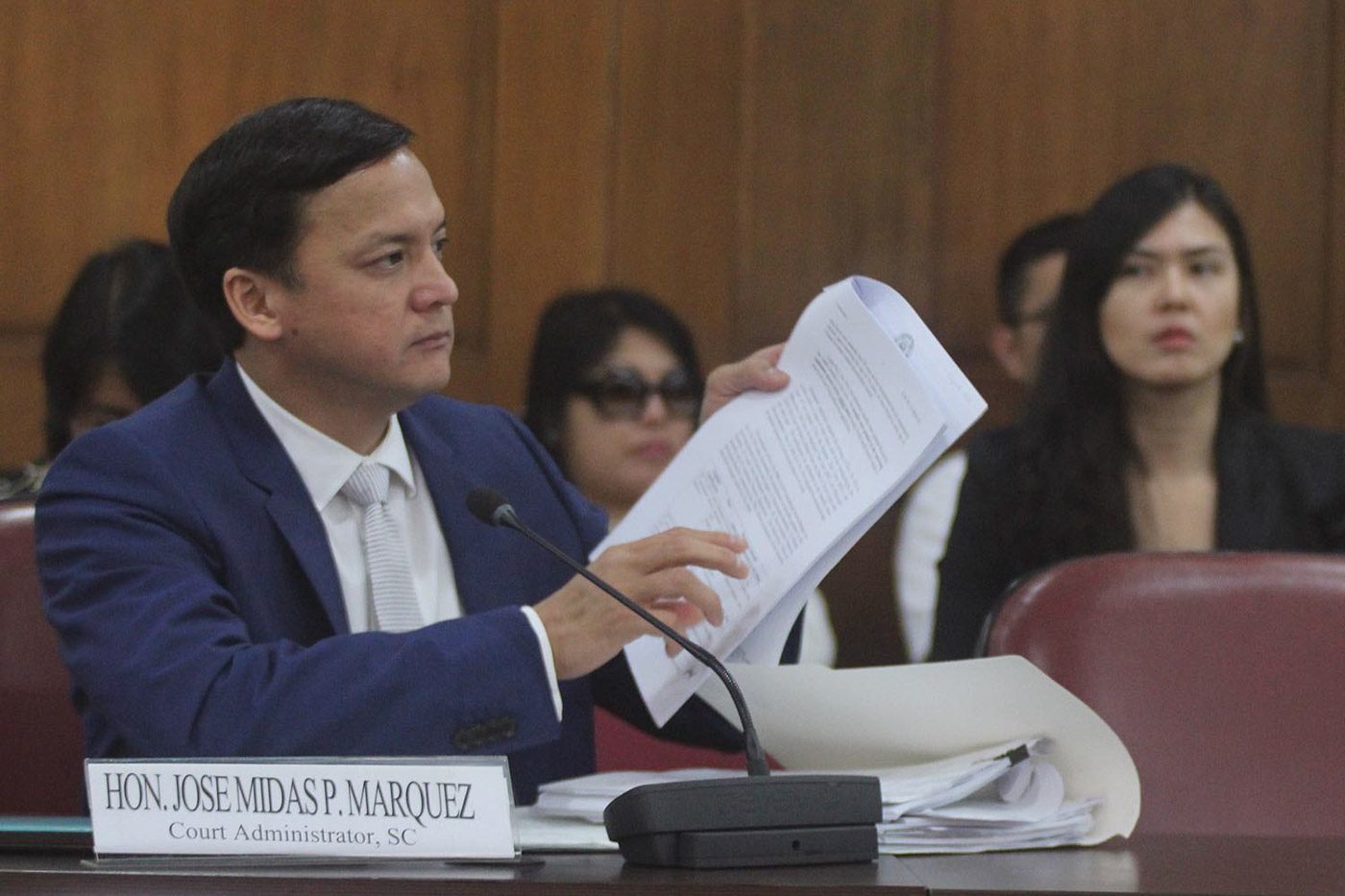SUMMARY
This is AI generated summarization, which may have errors. For context, always refer to the full article.

MANILA, Philippines (UPDATED) – Court Administrator Midas Marquez said on Tuesday, December 5, that benefits for survivors of judges and justices were delayed by over two years since 2015, when Supreme Court Chief Justice Maria Lourdes Sereno created technical working groups to attend to the matter.
Lawyer Larry Gadon accuses Sereno of committing culpable violation of the Constitution “when she delayed action on the numerous petitions for retirement benefits of justices and judges, and the surviving spouses of justices and judges.”
Marquez made a Powerpoint presentation to demonstrate the difference in the speed of approval of benefits before and after technical working groups (TWGs) were created.
He said that before the creation of TWGs in 2015, the Supreme Court en banc approved with dispatch 271 cases of benefits applications filed from 2010, when the law was passed, to October 2015, when the special committee was created.
Marquez said it only used to take the en banc 2-3 weeks before approving an application, but after the 2015 TWGs, it took the en banc over two years to decide on 12 applications. He said the latest approvals were even made only after the issue was brought up in the impeachment complaint.
Jose Deinla, Sereno’s spokesperson, said the delay was never intended. Deinla said the SC just wanted to have a consistent process, which was why the TWGs were created.
“There was delay because they needed to resolve policy issues. Before, the applications were resolved on an ad hoc basis, but the Supreme Court decided later on to make the process more consistent,” Deinla said in Filipino.
Retroactive or prospective law?
Republic Act 9946, enacted in 2010, grants benefits to spouses of deceased judges and justices.
There was an issue over whether widows or widowers are entitled to benefits if their spouses died before 2010, or only after the law was enacted.
In the 271 previous approved cases, Marquez said the SC en banc applied a retroactive principle, but set some limits. The en banc gave retirement benefits, but not from the time their spouse died but from 2010, when the law had been put in place.
Marquez’s office as court administrator did the first screening of applications.
“There is an adverse or opposite view in the Supreme Court. They said we couldn’t allow that because the law is prospective,” Marquez said in Filipino.
Marquez said that was when the Special Committee on Retirement and Civil Service Benefits was created in 2015.
Asked if Sereno caused the committee’s creation, Marquez said he would not know. The creation order was signed by Sereno and the two other senior justices, Antonio Carpio and Presbitero Velasco Jr.
Technical working groups
After the special committee was created, two TWGs were created under it.
Marquez presented a document that proves Sereno created the first TWG in December 2015, and an administrative order from the en banc that says a second TWG was created after that.
Asked if Sereno also created the 2nd TWG, Marquez said, “Malamang po (Most possibly).”
Asked whether the creation of the TWGs was approved by the en banc, Marquez said: “Kung si Chief Justice lang po ang nakapirma, most probably po hindi po alam ng court en banc.” (If the Chief Justice is the only signatory, most probably the en banc did not know.)
Marquez said that after the creation of the TWGs, there were 25 applications received, and only 12 of them had been approved.
He said these were only acted upon because it had been brought up as an impeachment issue.
Marquez said the 12 applications were put on the en banc agenda only in August 2017, despite them having been referred to the en banc from late 2015 to first quarter of 2016. Marquez noted Gadon first brought it up in a press conference late July 2017, a month before it was included in the court agenda.
The 12 applications were approved on November 7, 2017.
There are no actions yet on the 13 other applications.
Sereno’s lawyers said that when the Chief Justice created the TWGs, she was just performing a power given to her by the special committee.
“CJ Sereno merely implemented the terms of the memorandum creating the special committee since it is empowered to recommend the creation of sub-committees to discharge its functions,” they said in a statement.
Marquez and Sereno
It is Marquez who refers the applications to the en banc.
Marquez also said that due to followups from applicants with his office, he wrote Sereno but never got a response.
This is the second time that Marquez is appearing before the House justice committee. He first testified on the issue of the Regional Court Administrator’s Office (RCAO) being removed from his jurisdiction through an alleged unauthorized order from Sereno.
Marquez stood as spokesman for the court under the time of the late Chief Justice Renato Corona, whom Sereno did not agree with all the time on matters of the court.
Sereno also once had a dispute with Marquez on the latter’s interpretation of a court decision.
Marquez has been nominated to be a Supreme Court justice under the Duterte administration, but has yet to make the shortlist. – Rappler.com
Add a comment
How does this make you feel?
There are no comments yet. Add your comment to start the conversation.